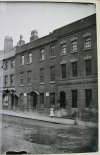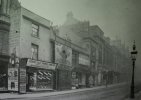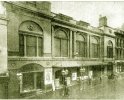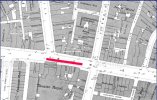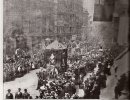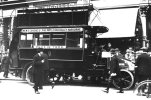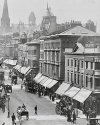-
Welcome to this forum . We are a worldwide group with a common interest in Birmingham and its history. While here, please follow a few simple rules. We ask that you respect other members, thank those who have helped you and please keep your contributions on-topic with the thread.
We do hope you enjoy your visit. BHF Admin Team
You are using an out of date browser. It may not display this or other websites correctly.
You should upgrade or use an alternative browser.
You should upgrade or use an alternative browser.
New Street City Centre Birmingham
- Thread starter postie
- Start date
brummy-lad
master brummie
A Sparks
master brummie
I wonder whereabouts that would have been?
I wonder whereabouts that would have been?
i wondered that sparks..can you make out any clues for a kellys look up...im struggling..would think its all demolished now
lyn
The more imposing building to the right of the shops is the theatre royal
View attachment 197414
thanks mike so do you have map showing the location please
lyn
A Sparks
master brummie
Thanks!The more imposing building to the right of the shops is the theatre royal
View attachment 197414
The slope of the street did indicate it might be on that side.
Unusual double grouping of street lamps.The more imposing building to the right of the shops is the theatre royal
View attachment 197414
Radiorails
master brummie
Just a thought.....it maybe that the theatre being a well patronized place would need good lighting at the entrance for safety reasons, plus it would be more inviting. Older types of gas lamps need a serviceable mantle, which was serviced by the lamplighter,
Richard Dye
master brummie
Very good point!Just a thought.....it maybe that the theatre being a well patronized place would need good lighting at the entrance for safety reasons, plus it would be more inviting. Older types of gas lamps need a serviceable mantle, which was serviced by the lamplighter,
Richard Dye
master brummie
Wonderful photo and the “street view” right hand picture showing the columns, what magnificent architecture and at least 114 years old and still going strong!This is listed as a 1912 view of the first motor bus in birmingham. It is in New Street, outside H. J Nicoll, ladies & gentlemens merchant tailors at 39 New St. £9 Nes st is now Claires, and the columns in the photo can still be seen on streetview
View attachment 203545

DavidGrain
master brummie
Just being pedantic. The Midland Red, original official name Birmingham and Midland Motor Omnibus Company Ltd. was founded in 1904 and other BET companies were operating bus services at that time whose bus services the Midland Red took over. The BET logo is displayed on the side of the bus which was used before they changed to displaying the MIDLAND name.
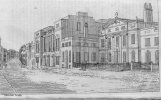
Here is a sketch of New street in 1817 from the short-lived publication The Birmingham Inspector, which only lasted 8 months. The impressive building in the centre is the original Theatre Royal. To the right of it is Portugal House, This was originally the home of Joseph Green, a merchant, who was made bankrupt in 1799. It seems to have been a linen warehouse for a while, but by at least 1807 it was the establishment of Mrs Thomas , who, from 10.00am till 4.00 pm, took orders for her millinery and Mantuas (apparently an overgown or robe typically worn over stays, stomacher and either a co-ordinating or contrasting petticoat). According to Wikipedia at this time the article had somewhat fallen out of fashion, though possibly not in Birmingham. The building was put up for sale in 1810 ( perhaps the decline in mantuas had reached Birmingham). For some time it was occupied by Hickin & Dunsford, distillers & spirit merchants, but it may have been used as an auction site, as in 1822 there was a sale there of the belongings of Lucien Buonaparte, the younger brother of Napoleon. He had some disagreements with his brother, and spent about four years in England till 1814, living for a time in Ludlow.
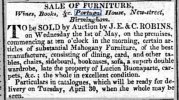
In 1823 it became a wine merchants under S.A.Wheeler. The wine side was pushed at first, but later he seemed to concentrate more on distilling, presumably gin. The premises, both house and distillery were sold in 1830. Later the building became the New royal Hotel
Richard Dye
master brummie
Wonderful building!View attachment 209885
Here is a sketch of New street in 1817 from the short-lived publication The Birmingham Inspector, which only lasted 8 months. The impressive building in the centre is the original Theatre Royal. To the right of it is Portugal House, This was originally the home of Joseph Green, a merchant, who was made bankrupt in 1799. It seems to have been a linen warehouse for a while, but by at least 1807 it was the establishment of Mrs Thomas , who, from 10.00am till 4.00 pm, took orders for her millinery and Mantuas (apparently an overgown or robe typically worn over stays, stomacher and either a co-ordinating or contrasting petticoat). According to Wikipedia at this time the article had somewhat fallen out of fashion, though possibly not in Birmingham. The building was put up for sale in 1810 ( perhaps the decline in mantuas had reached Birmingham). For some time it was occupied by Hickin & Dunsford, distillers & spirit merchants, but it may have been used as an auction site, as in 1822 there was a sale there of the belongings of Lucien Buonaparte, the younger brother of Napoleon. He had some disagreements with his brother, and spent about four years in England till 1814, living for a time in Ludlow.
View attachment 209887
In 1823 it became a wine merchants under S.A.Wheeler. The wine side was pushed at first, but later he seemed to concentrate more on distilling, presumably gin. The premises, both house and distillery were sold in 1830. Later the building became the New royal Hotel
BrummieGeoff
Sparkhill Lad
A very interesting annotated sketch of the top end of New Street dated 1814 that shows the Panorama and Post Office .... and other buildings in that part of the street.
The sketch is from the Royal Birmingham Society of Artists collection, and is currently on display in the "Mapping the Archive" exhibition at their Brook Street gallery.
The notes at the bottom read (from the left):
- Judd Wagon Warehouse. Daily Wagon to London & Banbury
- Campbell Spar Ornament Warehouse and Museum
- Panorama
- Hunts' Pattern Card. Hay & Straw Warehouse
- Malcot Web Manufactory EDIT: T Walcot listed in 1818 Directory with Coach, Livery lace and Fringe manufactory, New Street
- Galmatz Garden
- Mail Coach Gateway
- Post Office. M Gallmatz house EDIT: Miss Gottwaltz listed in 1818 Directory as Postmistress, New Street
- Letter Office
- Mail Coach Gateway
- Dore Boot & Shoe Maker
- Sheldon Metal Warehouse
- Sheldon
- Temple St
- Miriam Anox?? V Sem Firsham??
- John Newbold Plumber & Painter
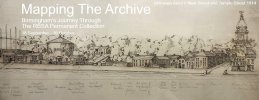
The sketch is from the Royal Birmingham Society of Artists collection, and is currently on display in the "Mapping the Archive" exhibition at their Brook Street gallery.
The notes at the bottom read (from the left):
- Judd Wagon Warehouse. Daily Wagon to London & Banbury
- Campbell Spar Ornament Warehouse and Museum
- Panorama
- Hunts' Pattern Card. Hay & Straw Warehouse
- Malcot Web Manufactory EDIT: T Walcot listed in 1818 Directory with Coach, Livery lace and Fringe manufactory, New Street
- Galmatz Garden
- Mail Coach Gateway
- Post Office. M Gallmatz house EDIT: Miss Gottwaltz listed in 1818 Directory as Postmistress, New Street
- Letter Office
- Mail Coach Gateway
- Dore Boot & Shoe Maker
- Sheldon Metal Warehouse
- Sheldon
- Temple St
- Miriam Anox?? V Sem Firsham??
- John Newbold Plumber & Painter

Last edited:
Richard Dye
master brummie
It is very interesting, I have never seen anything quite like that!A very interesting annotated sketch of the top end of New Street dated 1814 that shows the Panorama and Post Office .... and other buildings in that part of the street.
The sketch is from the Royal Birmingham Society of Artists collection, and is currently on display in the "Mapping the Archive" exhibition at their Brook Street gallery.
View attachment 211025
Yes very interesting. This would have been a drawing of the odd numbers side (well at least today it is) Edit - correction, buildngs on this side of New Street have both odd and even numbers.
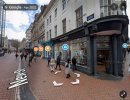
Tracked down
Campbell - he was in the 'Fancy Trade'
Judd and Sons were carriers and wharfingers.
The Panorama was Parker's Panorama by 1818. This might be the address Campbell used for his advert response 'Museum, New Street'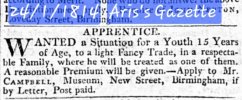
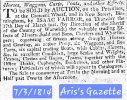
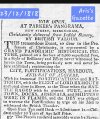
Source: British Newspaper Archive

Tracked down
Campbell - he was in the 'Fancy Trade'
Judd and Sons were carriers and wharfingers.
The Panorama was Parker's Panorama by 1818. This might be the address Campbell used for his advert response 'Museum, New Street'



Source: British Newspaper Archive
Last edited:
There is a thread on the Panorama at https://birminghamhistory.co.uk/forum/threads/panorama-–-the-first-rotunda.31354/
Richard Dye
master brummie
I hope that street is still there, it is beautiful and shows how good Birmingham is! Classy!Yes very interesting. This would have been a drawing of the odd numbers side (well at least today it is)
View attachment 211031
Tracked down
Campbell - he was in the 'Fancy Trade'
Judd and Sons were carriers and wharfingers.
The Panorama was Parker's Panorama by 1818. This might be the address Campbell used for his advert response 'Museum, New Street' View attachment 211033
View attachment 211037View attachment 211035
Source: British Newspaper Archive
There's a thread about the early post offices here too:
As the postmistress in 1818 (4 years later) was Georgina Gottwalty, she may have been the same family, perhaps Georgina was the daughter of the 1814 Postmaster, M Gottwalz.
Gottwalty" is a surname that appears in various records, but the most likely connection is to the German surname "Gottwaltz" or "Gottwalo,"
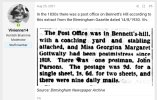
Thank you Richard that’s a great addition to this thread. I think the second and third buildings depicted in the drawing are new information which I don’t think has been mentioned before. It certainly helps to make sense of the reference to the New Street Office in the September 1877 newspaper article below. I couldn’t relate the description of the interior with Post Office #1 in the drawing.
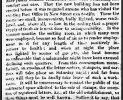
It’s surprising (and slightly confusing) as to how many central Post Offices there have been. But the drawing provides the missing links. Viv.

It’s surprising (and slightly confusing) as to how many central Post Offices there have been. But the drawing provides the missing links. Viv.
As the postmistress in 1818 (4 years later) was Georgina Gottwalty, she may have been the same family, perhaps Georgina was the daughter of the 1814 Postmaster, M Gottwalz.
Gottwalty" is a surname that appears in various records, but the most likely connection is to the German surname "Gottwaltz" or "Gottwalo,"

Last edited:



